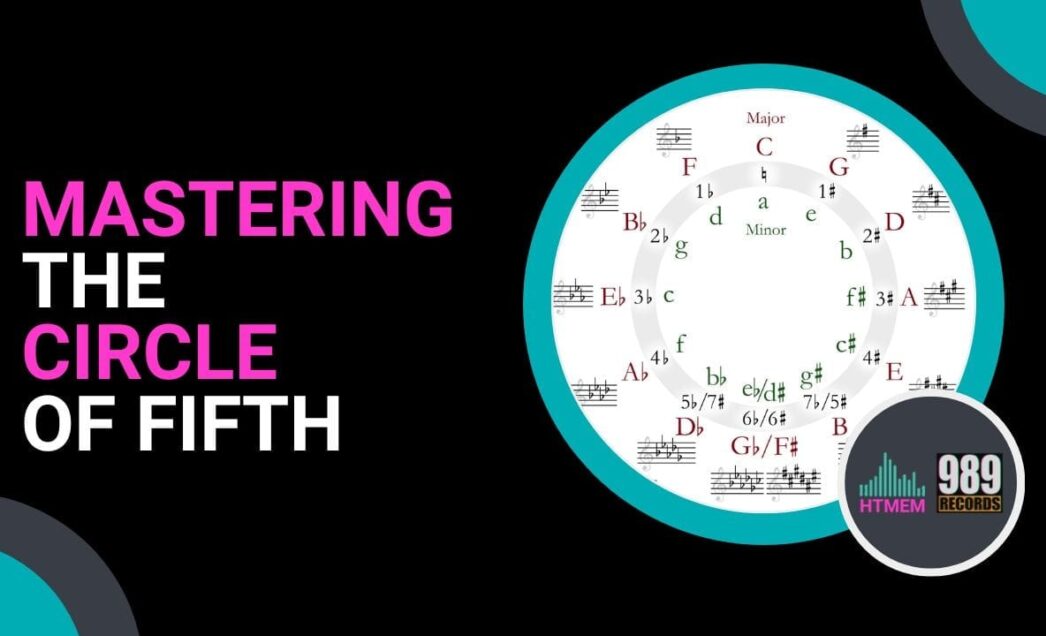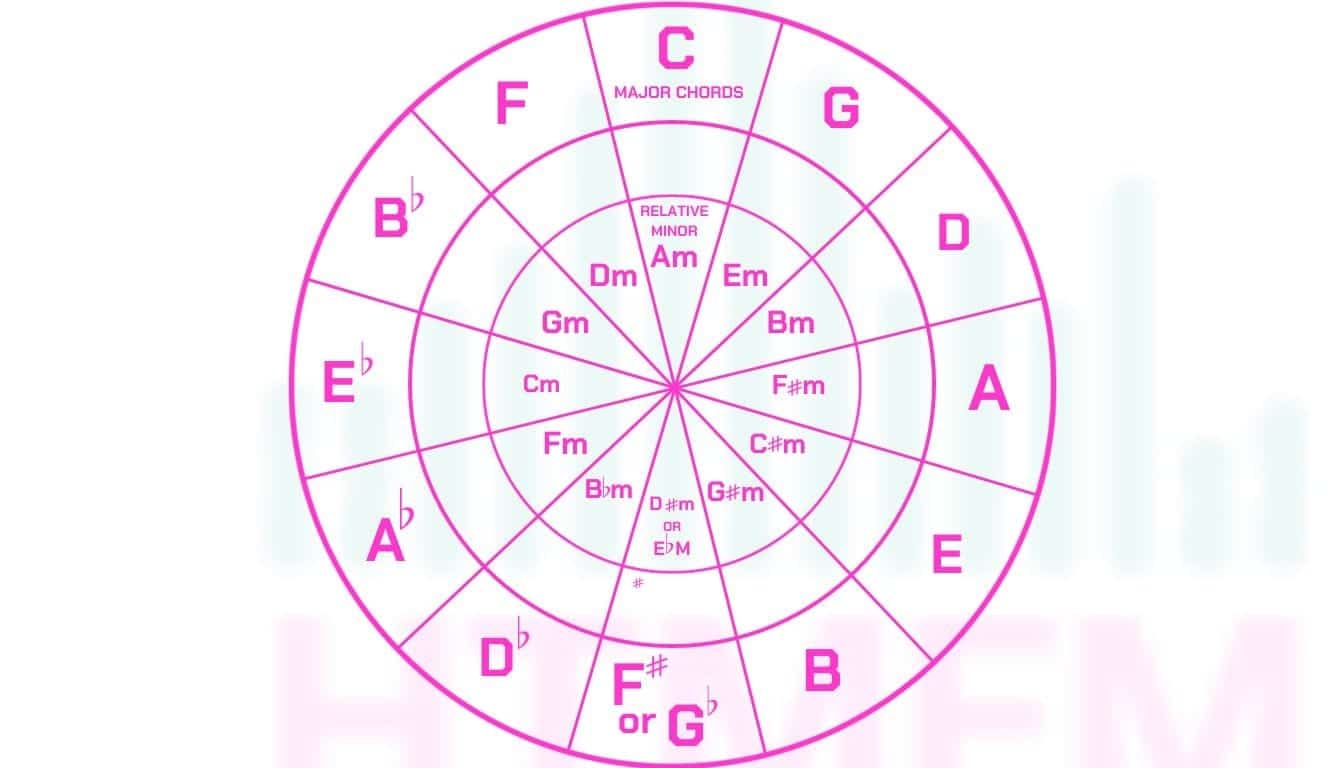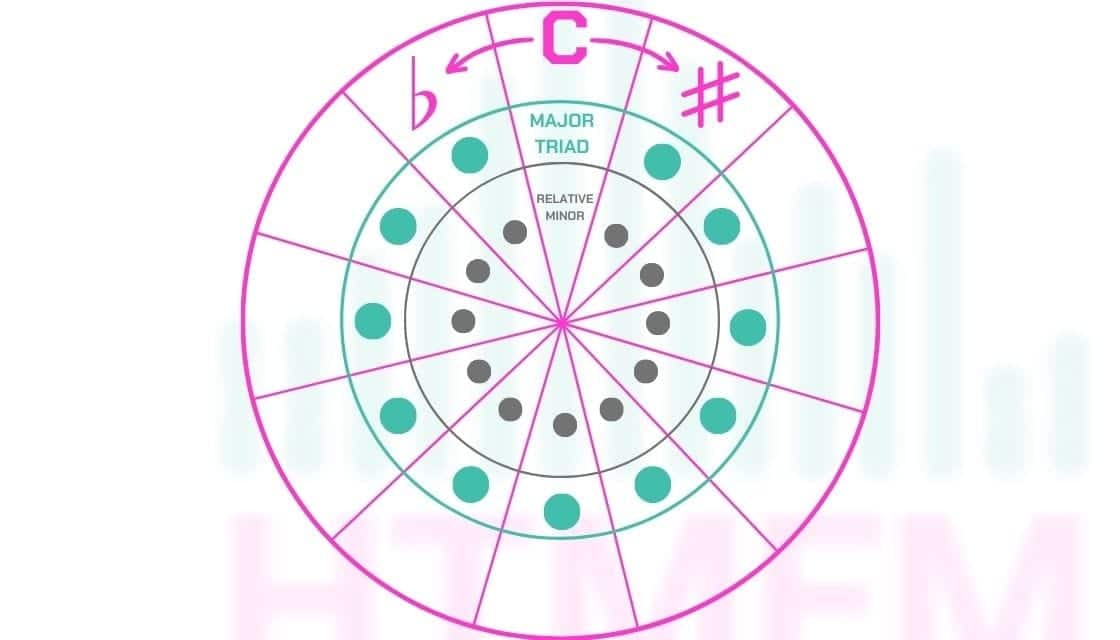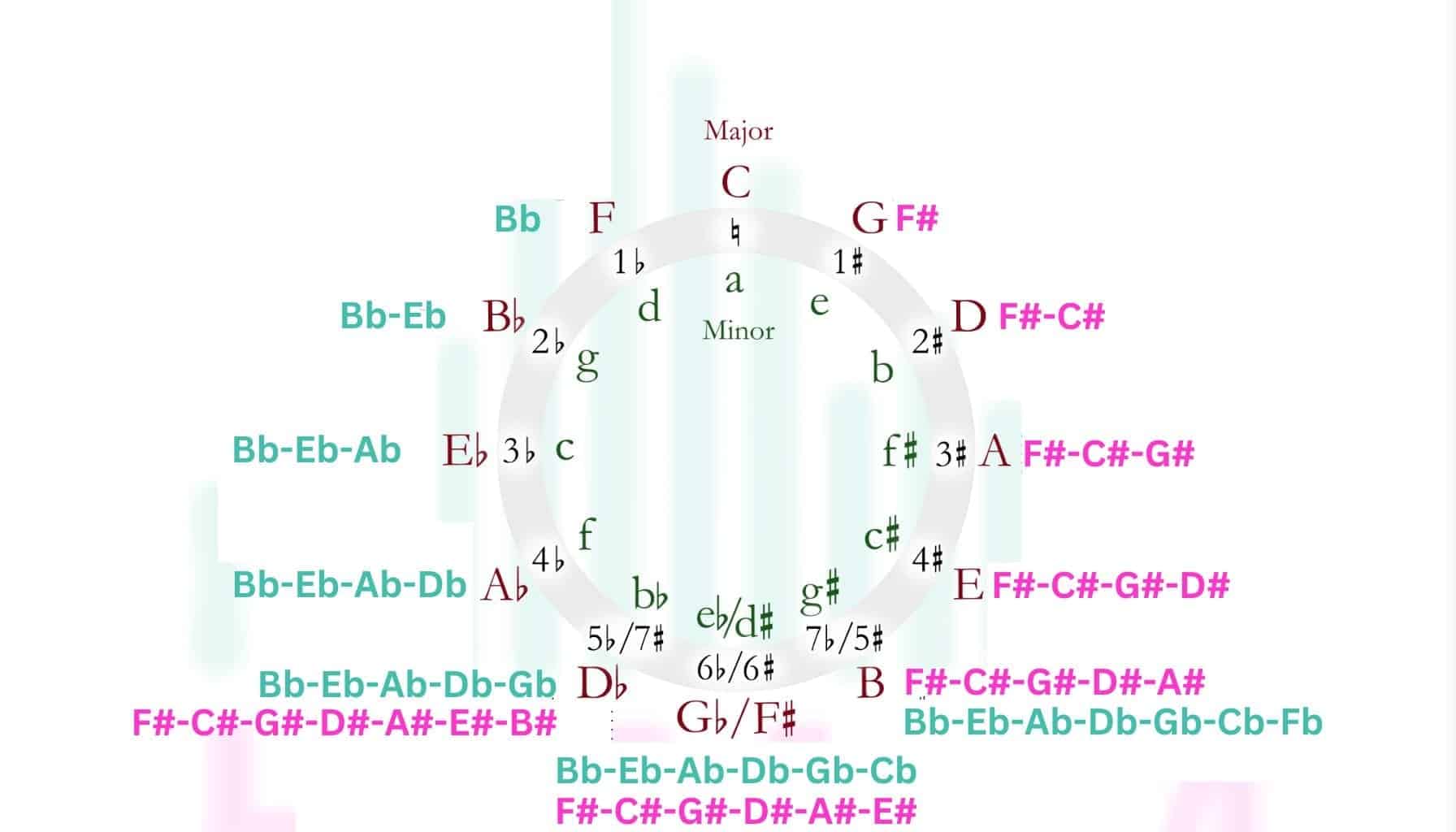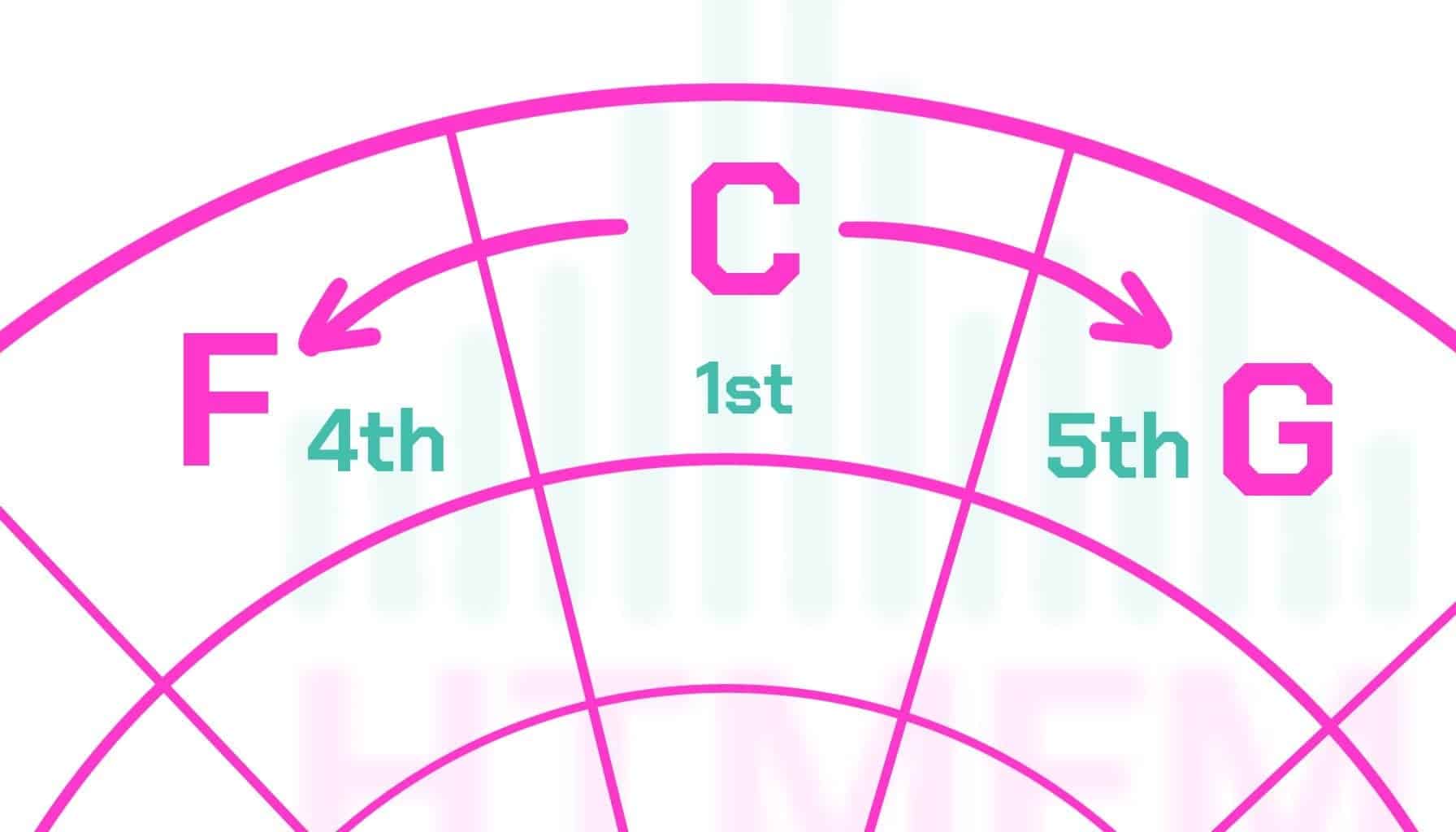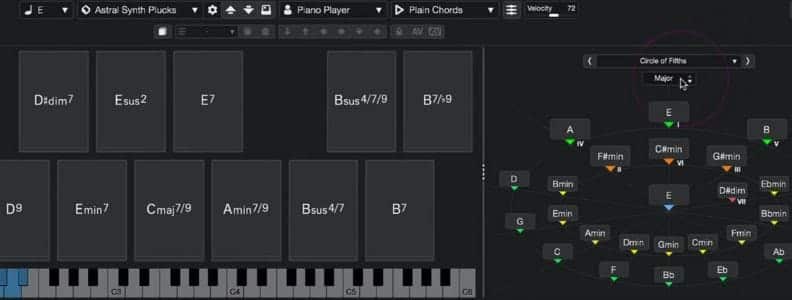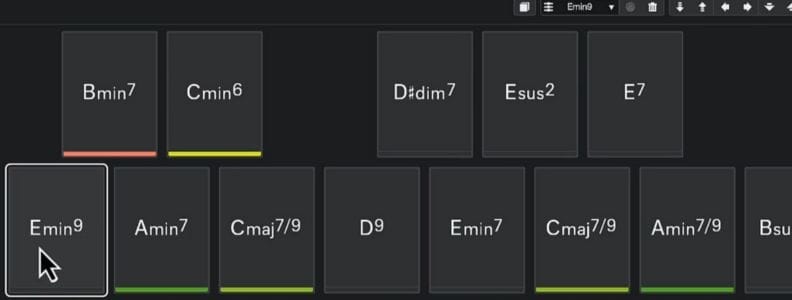Struggling to identify key signatures or harmonize chords with ease?
The Circle of Fifth is not just a concept but a practical tool for musicians navigating the complex landscape of Western music. It is the key (no pun intended) to mastering musical relationships, from key signatures to harmonious chord progressions. Dive into our guide to unlock the potential of the Circle of Fifths and enhance your musical proficiency.
Too Complicated? The Cubase Chord Pad and Chord Track provide a straightforward and user-friendly method for easily constructing your harmonies and chord progressions. Learn more about this in our Cubase Course Here.
Takeaways
- The Circle of Fifths is a fundamental musical tool that outlines the relationships between keys, scales, and chords, aiding in composition, key understanding, and harmonic progression.
- Musicians can use the Circle for practical applications such as transposition, improvisation, and pattern recognition in music, as well as a guide for seamless modulation between keys.
- Beyond its basic uses, mastering the Circle of Fifths involves advanced concepts like various tuning systems and enharmonic equivalents, allowing a deeper understanding of music theory and composition.
Table of Contents
Unlocking the Secrets of the Circle of Fifths
Harmonic Navigation: Chords and Progressions
Practical Applications for Performers and Composers
Tools and Resources to Master the Circle
Fine-Tuning Your Skills: Advanced Concepts
Summary
FAQ
Unlocking the Secrets of the Circle of Fifths
Ever pondered the structure that ties the world of music together? Look no further than the Circle of Fifths.
This seemingly simple diagram, with its sequence of pitches arranged in a circle, serves as a roadmap to the intricate relationships between musical keys, making it an essential tool in the arsenal of every musician.
From the masterpieces of J.S. Bach to the latest pop hits, the Circle of Fifths has been an integral part of music composition, aiding in understanding key relationships, chord progressions, and modulation.
Despite its initial complexity, the Circle of Fifths becomes less daunting once you familiarize yourself with its core principles.
Let’s understand something More!
The Anatomy of the Circle
Imagine the Circle of Fifths as a clock, but replacing hours with musical keys.
Positioned at the top of the circle, like 12 o’clock, is the key of C Major, having neither sharps nor flats (“#” and “b”). As you move in a clockwise direction, you add a sharp to each key, while a counterclockwise movement adds flats.
The Circle of Fifths also depicts the relationship between major and minor keys. The Major chords are located in the outer circle, and the minor chords are found in the inner circle.
The relative minor key of a major key can be found by moving from the outer circle to the inner circle. For instance, A minor serves as the relative minor of C major, and they both share the same key signature, which consists of no accidentals (no “#” or “b”). Similarly, the relative major of a minor key can be found by moving from the inner circle to the outer Circle.
Decoding Key Signatures
Accidental symbols (“#” and “b”) constitute the key signature, dictating the pitches in a key. It helps to establish the scale and tonality of a piece of music.
The Circle of Fifths simplifies this concept by visually representing the key signatures and their relationships, aiding in recalling which accidentals are needed for specific keys.
Let’s now consider a Major Scale, in this case, the D Major Chord Scale where the first chord is constituted by the triad D-F#-A.
To find the number of sharps in a scale, one can take the tonic of the chord (in this case the D key) and subtract a semitone (a half-step) to identify the last note in the scale that has a sharp. In this case C#.
Then, for the major scales, you can determine the number of sharps by following this scheme: F-C-G-D-A-E-B (Father-Christmas-Gave-Dad-An-Electric-Blanket).
In our case, starting from the F, the keys with the sharp will be F and C (the last note), they are the exact accidentals we can find in the D Major Scale.
Got it?
Another example. How many sharps are there in the A Major Scale?
Tonic: A
A semitone back: G#
Have a look at the image below. G is the last note with a sharp, the sequence is F-C-G and the complete scale is A-B-C#-D-E-F#-G#-A.
A similar method can be used to determine the number of flats in a key by inverting the major sequence above to B-E-A-D-G-C-F.
The image below summarizes the various accidentals that can occur in the circle of fifths, providing a comprehensive overview.
Navigating Major and Minor Scales
In essence, the Circle of Fifths visually encapsulates the relationships between major and minor scales, as well as the scale degree connections within them.
Each segment of the circle represents a musical key and its corresponding major and minor scales, with C major positioned at the top. As the circle progresses clockwise, each key adds one sharp to its key signature, while counterclockwise progression adds one flat.
To identify a minor scale, you just need to jump from the outer to the inner segment of the circle, by locating a major key on the circle, you can also identify its relative minor.
So if we are in G Major, the relative minor scale is the e min.
Harmonic Navigation: Chords and Progressions
Beyond being a tool for comprehending musical keys, the Circle of Fifths also guides you through the realm of harmony and chord progressions creation.
By identifying the tonic of the key (1st grade) on the Circle of Fifths, musicians can readily ascertain the 4th and 5th chords to construct fundamental progressions that are harmonious and enjoyable (1st-4th-5th), which is also a classic blues progression.
The Circle of Fifths also provides a visual representation of borrowed chords.
These are chords introduced from a key outside the primary key, typically from keys that are neighboring on the Circle of Fifths, to produce distinctive harmonic effects within a musical composition.
The image displayed above circle of fifths Steinberg Cubase’s Chord Pad.
This tool is an easy, potent, and efficient creator of chord progressions, equipped with an integrated Circle of Fifths assistant.
Make your musical life easier.
Consider enrolling in the dedicated Cubase Course available here at HTMEM Academy.
Crafting Chord Progressions
Consider the Circle of Fifths as a palette, allowing you to craft a wide array of vibrant chord progressions. By interpreting the letters as chords and shifting one position clockwise from the root chord, you can formulate robust progressions.
The chord in that position frequently serves as the dominant chord (5th), naturally leading to the root chord (1st).
Certain progressions are more prevalent due to their pleasing sound and historical usage by songwriters. The Circle of Fifths explains this by serving as a structure for crafting harmonically robust chord progressions that ultimately return to the tonic or key center.
Cubase utilizes a specific color scheme, enabling you to effortlessly understand the concepts of crafting both conventional and innovative progressions.
Bottone corso Cubase
Modulating Between Keys
Modulation, the process of transitioning between scales, can inject intrigue and diversity into a piece of music. Basically, the modulation means changing the key
The Circle of Fifths, with its circular arrangement of the twelve major keys, each positioned a fifth away from the preceding key, can guide these transitions seamlessly.
Effective techniques for achieving seamless key modulations by utilizing the Circle of Fifths involve:
- Delving into the theoretical aspects of modulations
- Leveraging the Circle of Fifths to determine key signatures
- Experimenting with abrupt modulations or pivot chords
- Crafting compelling melodies by incorporating notes from the major or minor scale of the current key.
Bottone Corso Cubase – Easily Compose With Cubase
Exploring Adjacent Keys
Adjacent keys on the Circle of Fifths, sharing common diatonic chords and major chords, can be used as pivot chords for modulation, facilitating smooth transitions, and maintaining harmonic relationships.
Transitioning between adjacent keys can generate distinctive harmonic effects due to the harmonious blending of these keys, resulting in seamless transitions.
Do you want to make your composition process easier?
Learn Cubase Now
Practical Applications for Performers and Composers
The Circle of Fifths extends beyond theory, offering numerous practical implications for performers and composers.
Whether you are transposing a piece to a different key, improvising a solo, or trying to recognize patterns in popular songs, the Circle of Fifths can be a powerful ally.
For instance, in the realm of transposition, the Circle of Fifths can simplify the process of moving a piece of music to a new key. It provides a visual guide that can help you quickly identify the new set of chords you’ll need to use.
Transposition Techniques
Musicians often find themselves transposing music.
Whether you’re adapting a song for a singer’s vocal range, trying to play a piece on a different instrument, or just experimenting with different musical colors, transposition is a skill you’ll use frequently.
The Circle of Fifths can simplify transposition by visually representing the connections between major and minor scales, keys, and key signatures.
It assists in identifying the key signature of a piece, recognizing chords that harmonize with that key, and smoothly changing the song to a different key.
Improvisation and Jamming
Many musicians deem improvisation and jamming crucial, where the Circle of Fifths can serve as an irreplaceable guide.
In the context of music improvisation and jamming, the Circle of Fifths serves as a visual representation of the relationship between chords and key signatures, thereby assisting in the development of seamless chord progressions and enhancing comprehension of harmonic movement.
Creating compelling solos using the Circle of Fifths involves:
- Beginning in a specific key
- Proceeding to move two keys in a clockwise direction
- Playing through the chords counterclockwise to integrate various chord progressions and modal explorations.
Recognizing Patterns in Popular Songs
Beyond composition and improvisation, the Circle of Fifths also proves itself as a valuable analytical tool.
The Circle of Fifths aids in the recognition of patterns in popular music by providing musicians with the ability to easily determine the number of sharps or flats in each key and comprehend the relationships between different keys.
Recognizing these patterns can help musicians in the following ways:
- Learn and analyze music more quickly and efficiently
- Identify common chord progressions
- Understand the structure of a song
- Predict where a melody might go next
Tools and Resources to Master the Circle
Attaining mastery over the Circle of Fifths demands practice and suitable resources. Fortunately, there are numerous tools and strategies available that can help you internalize the Circle and its applications. Some resources to consider include:
- Cubase Chord Assistant and Chord Track. Start Learning Cubase Here
- Books that provide in-depth explanations and exercises on the Circle of Fifths
- Mobile applications that offer interactive learning experiences and practice exercises
- High-quality Circle of Fifths charts that you can refer to while practicing or composing music
With these resources, you can find a learning method that suits your style and effectively master the Circle of Fifths.
An Interactive Circle of Fifths Chart is a digital tool used in music theory to:
- Visually represent and manipulate scales, notes, chords, and keys
- Assist in analyzing chord progressions
- Transpose music
- Identify the key of musical compositions
It is a helpful tool for musicians and music students.
Interactive Circle of Fifths Chart
In today’s digital world, interactive Circle of Fifths charts can prove to be invaluable resources for learning and practice.
This tool offers a visual depiction of the interconnectedness of musical notes, keys, and chords, facilitating the capacity to compose, improvise, and comprehend harmonic progressions with greater ease.
Some of the highly recommended Interactive Circle of Fifths Charts can be found on Muted.io, ToneGym, and Rand Scullard.
These charts are known for their helpful features and user-friendly interfaces, making them a valuable resource for anyone seeking to master the Circle of Fifths.
Memorization Strategies
For efficient usage, memorization of the Circle of Fifths is crucial. There are numerous mnemonic devices and strategies to help musicians commit the Circle to memory. For example, using the note C as a reference point and then counting five letters up to determine the next note in the circle can be a simple yet effective strategy.
Engaging in exercises such as:
- playing a fifth up from each note starting on C and following the circle clockwise
- practicing the entire circle rather than just a few keys
- varying the starting point instead of always beginning at C major
can enhance retention of the Circle of Fifths.
Or… You can Start Understanding How to Use Cubase Now.
Fine-Tuning Your Skills: Advanced Concepts
For proficient musicians, the study of the Circle of Fifths extends beyond the basics. There are concepts beyond equal temperament and enharmonic equivalents that can add complexity to the Circle and its applications. Understanding these concepts can enhance a musician’s proficiency by facilitating easier music reading and comprehension and enabling them to understand the varied functions of chords in different musical contexts.
In addition to equal temperament, other tuning systems in music theory include:
- Pythagorean
- Mean-tone
- Just intonation
- Well temperaments
Various tuning systems have the potential to significantly alter the music they are applied to, resulting in expressive variations in color and emotion.
Beyond Equal Temperament
The Circle of Fifths relies on the equal temperament system, subdividing the octave into twelve equivalent parts.
However, other tuning systems exist, and understanding these systems can deepen your understanding of the Circle and its applications.
Utilizing more intricate tuning systems like just intonation, such as 5-limit tuning, results in the use of a maximum of eight accurately tuned fifths and a minimum of three non-just fifths, thereby modifying the arrangement of the Circle of Fifths.
Enharmonic Equivalents and Theoretical Keys
Enharmonic equivalents, or differently designated notes producing identical sounds, can introduce an added layer of complexity to the Circle of Fifths.
These equivalents can facilitate the establishment of connections between different keys, enabling seamless transitions between keys.
Theoretical keys, keys that would have at least one double-flat or double-sharp in their key signatures, are particularly intricate and uncommon in practical application. However, understanding these keys can provide a deeper understanding of music theory and the Circle of Fifths.
Summary
From the intricate web of musical keys to the harmonious world of chord progressions, the Circle of Fifths is a powerful tool every musician should master. With its applications spanning from music composition to improvisation, the Circle of Fifths can enhance your musical performance, comprehension, and creativity.
So, whether you’re a budding musician looking to understand the basics of music theory or an advanced composer seeking to fine-tune your skills, the Circle of Fifths can guide you on your musical journey, unlocking the secrets of harmony and melody that lie at the heart of every musical piece.
Frequently Asked Questions
What is the circle of fifths explained?
The circle of fifths is a diagram that shows the relationships between the twelve different musical keys, based on the interval of a fifth, which is the distance between two musical notes that are five steps apart in the musical alphabet. It is used by musicians and composers to describe the musical relationships between pitches.
What the hell is this Circle?
The circle of fifths represents the relationship between different keys in music, with the keys containing sharps on the right and those containing flats on the left. The key of C major (and its relative minor A Minor), with no sharps or flats, sits at the center.
What is the saying for the circle of fifths?
The saying for the circle of fifths is “Father-Christmas-Gave-Dad-An-Electric-Blanket,” which helps to remember the order of the sharps. This sequence is essential to memorize when learning the circle of fifths.
What is the circle of fifths counting?
The circle of fifths is a diagram that illustrates the relationship between the 12 musical keys, arranged in a clockwise direction. It helps in understanding the key signatures and their relationships.
How does a circle of fifths work?
The circle of fifths is an arrangement of 12 notes in a circle, where each note is a perfect fifth apart. It starts with the note C at the top, and as you go clockwise around the circle, the notes move in perfect fifths.
What are other applications for the Circle?
If you are a DJ, you might be interested in understanding how harmonic mixing works. In this case, you can follow a dedicated DJ Course to better understand how to elevate your DJ sets and get the best from the sound system.
Suggested Readings
Steinberg Cubase Pro Music Production Software
Unleash Your DJ Skills: Master the Art of DJ – How to Mix
The Ultimate Waves Plug Guide: Find the Perfect Plugin for Your Music Production
Now Practice and Enjoy!

